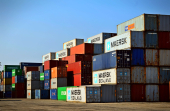Customs Transitrefers to the process of transporting goods through a customs territory without the need for the goods to be cleared for import or export at every border crossing. This procedure is essential for international trade, facilitating the movement of goods between countries while ensuring compliance with customs regulations.
Key Features
Temporary Movement:
- Goods can be moved from one customs office to another without being subjected to full customs duties or taxes at each point.
Customs Guarantees:
- A guarantee (often a financial bond) is usually required to cover potential duties and taxes that may be owed if the goods do not reach their final destination.
Simplified Procedures:
- Customs transit simplifies the paperwork and procedures involved in moving goods, reducing delays and costs for businesses.
Types of Customs Transit
1. Internal Transit:
- Movement of goods within a single country, often between customs offices or warehouses.
External Transit:
- Movement of goods between countries, often involving multiple customs jurisdictions. This may include processes like the Common Transit Convention in Europe.
Importance in International Trade
- Efficiency: Customs transit allows for quicker and more efficient transportation of goods, which is crucial for businesses relying on timely deliveries.
- Cost-Effectiveness: Reduces the need to pay duties multiple times, making it financially advantageous for companies involved in international trade.
- Regulatory Compliance: Ensures that goods are transported following the legal frameworks set by customs authorities, helping to avoid potential penalties.
Customs transit is a vital component of international logistics, enabling the smooth movement of goods across borders while adhering to customs regulations. It plays a significant role in enhancing trade efficiency and supporting global commerce.
Businesses face several challenges when dealing with customs transit, which can impact the efficiency and costs of their operations. Here are some of the main challenges:
1. Complex Regulations
- Varied Rules: Different countries have different customs regulations, making it challenging for businesses to stay compliant.
- Frequent Changes: Customs laws and regulations can change frequently, requiring constant updates and adjustments to procedures.
2. Documentation Requirements
- Extensive Paperwork: The need for detailed documentation can be overwhelming, and missing or incorrect documents can lead to delays.
- Language Barriers: In international trade, language differences can complicate the preparation and understanding of required documents.
3. Financial Guarantees
- Bonding Costs: Businesses often need to provide financial guarantees (bonds) to cover potential duties and taxes, which can strain cash flow.
- Risk of Loss: If goods do not reach their destination, businesses may face significant financial losses if guarantees are invoked.
4. Delays and Transit Times
- Unpredictable Delays: Customs inspections can cause unexpected delays, impacting delivery schedules and customer satisfaction.
- Logistical Challenges: Coordinating transportation routes and schedules can be complex, especially when multiple customs jurisdictions are involved.
5. Compliance Risks
- Penalties and Fines: Non-compliance with customs regulations can result in heavy fines and penalties, affecting a company’s reputation and financial standing.
- Legal Issues: Failure to comply may lead to legal disputes, further complicating operations.
6. Technological Barriers
- Outdated Systems: Some businesses may struggle with outdated customs management systems that hinder efficiency.
- Integration Challenges: Integrating customs processes with other logistics and supply chain systems can be complex and costly.
7. Training and Expertise
- Lack of Knowledge: Businesses may lack the necessary expertise in customs regulations and processes, leading to errors and inefficiencies.
- Training Costs: Continuous training and development for staff to keep up with customs changes can be resource-intensive.

Navigating customs transit involves various challenges that can significantly affect business operations. Companies must invest in understanding regulations, improving documentation processes, and leveraging technology to mitigate these issues and enhance their efficiency in international trade.
Customs transit can include a wide variety of products across different categories. Here are some common types of products that typically fall under customs transit:
Consumer Goods
- Electronics: Smartphones, computers, televisions, and home appliances.
- Clothing and Textiles: Garments, fabrics, and footwear.
- Household Items: Kitchenware, furniture, and decor.
Industrial Products
- Machinery: Manufacturing equipment, construction machines, and tools.
- Raw Materials: Steel, aluminum, plastics, and other industrial inputs.
- Chemical Products: Industrial chemicals and materials used in production.
Food and Beverages
- Agricultural Products: Fruits, vegetables, grains, and livestock.
- Processed Foods: Canned goods, snacks, and packaged meals.
- Beverages: Alcoholic drinks, soft drinks, and bottled water.
Pharmaceuticals
- Medicines: Prescription drugs, over-the-counter medications, and medical supplies.
- Medical Devices: Equipment used for diagnosis, monitoring, and treatment.
Hazardous Materials
- Chemicals: Toxic substances, flammable materials, and other regulated items.
- Waste Products: Certain types of waste that require special handling.
Automotive Products
- Vehicles
: Cars, trucks, and motorcycles.
- Parts and Accessories: Engine parts, tires, and other automotive components.
Machinery and Equipment
- Construction Equipment: Cranes, bulldozers, and excavators.
- Agricultural Machinery: Tractors, harvesters, and plows.
Luxury Goods
- Jewelry and Watches: High-value items often subject to stricter regulations.
- Designer Fashion: High-end clothing, handbags, and accessories.

Customs transit encompasses a broad range of products, and the specific items included can vary based on the nature of the trade and the regulations of the countries involved. Proper handling of these products is essential to ensure compliance with customs laws and facilitate smooth transportation across borders.
Importing electronics through customs involves several key regulations and requirements that businesses must adhere to in order to ensure compliance and avoid delays. Here are the main considerations:
1. Import Licenses and Permits
- Licensing Requirements: Some countries require specific import licenses for electronic products, especially if they are classified as sensitive or controlled items.
- Permits for Specific Categories: Products like telecommunications equipment may require additional permits.
2. Compliance with Standards
- Safety Standards: Electronics must meet national and international safety standards (e.g., UL, CE, or FCC certifications) to ensure they are safe for consumer use.
- Environmental Regulations: Compliance with regulations such as RoHS (Restriction of Hazardous Substances) and WEEE (Waste Electrical and Electronic Equipment) directives may be necessary.